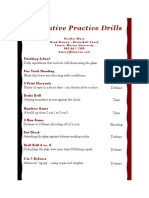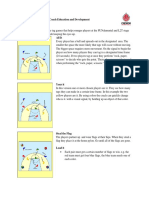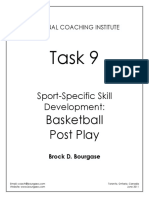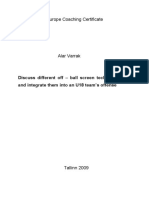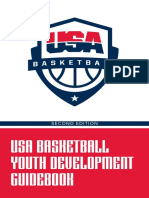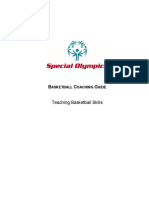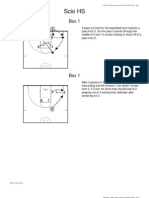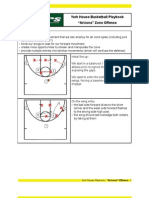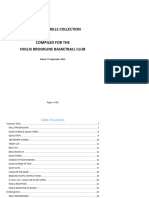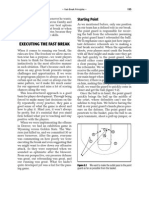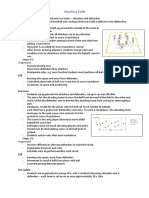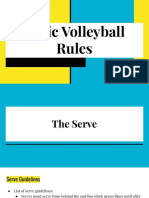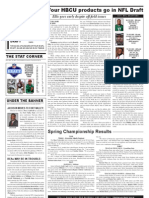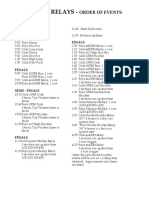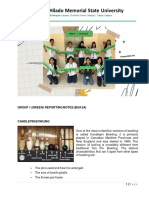How to Create Winning Basketball Lineups
Even at the earliest levels of basketball, one of the coach's most important responsibilities is planning
lineups and making substitutions. The right lineup puts your players into positions that highlight their
strengths while developing their skill sets for the future.
Whether your goal is to develop your athletes, win games, or just have fun, it's critical to understand the
roles and responsibilities of each position on the court... and put your athletes into a spot that
maximizes their chances of success.
In this short guide, we'll review the five key basketball positions, and give you some concrete tips to help
create winning lineups for your team.
The 5 Positions
For most youth basketball teams, you won't have many kids who walk in the door with an obvious
positional assignment. There won't be any 7-foot behemoths or lightning quick athletes with ball-on-a
string handles.
It often takes several practices and games to figure out each player's strengths, weaknesses and natural
gifts. And we always encourage youth coaches to give their players opportunities at multiple positions.
That said, as the season goes on, it's a good idea to establish one or two positions for each player. So
they can better learn the roles and responsibilities of that position and help contribute to the team in a
positive way.
Here's how the five positions typically break down:
1-Position (Point Guard, PG)
The point guard is your team's primary ballhandler. She is responsible for bringing the ball up
the court and initiating the offense
The point guard will be your team’s quarterback on the floor, so she should have a general
understanding of basketball strategy and have the ability to direct her teammates on the floor
and execute set plays.
She should be comfortable dribbling and passing the ball under heavy defensive pressure.
Shooting range and general scoring ability are important, but not essential. More importantly,
the point guard should be able to penetrate off the dribble and distribute the ball to other
players in high-percentage scoring areas (i.e. under the basket, open jumpshots etc.).
Your point guard should be mentally tough; she will often be called upon to handle the ball in
high-pressure situations, and should be confident in this role.
On the other side of the ball, she's your first line of defense - tasked with keeping the opposing
team's best playmaker out of the lane.
© eBasketballCoach.com
� You should have at least two players on your team who are comfortable playing the point guard
position. The backup PG may need to step in and run the team if the starter misses a game or
fouls out.
2-Position (Off Guard, Shooting Guard, SG)
Your off guards will sometimes be called upon to handle the ball in lieu of the point guard, so
they should also be comfortable in the open court under defensive pressure.
For younger teams, shooting guards should have the ability to execute a V-cut or L-cut to get
open on the wing, receive a pass from the PG and initiate your offense
Shooting guards should be able to shoot the ball from the outside, preferably with three point
range for older players .
They should have the ability to score off the dribble, defend well, and finish on the fast break.
The shooting guard is often asked to inbound the ball from the baseline, sideline, or under your
own basket. So they should be comfortable with your inbounds plays and press breaks, and be
willing and able to direct their teammates into the proper position
3-Position (Small Forward, SF)
Small forwards are typically your most versatile player - they are asked to do a little bit of
everything.
For younger teams, small forwards should have the ability to execute a V-cut or L-cut to get
open on the wing, receive a pass from the PG and initiate your offense
Small forwards will be called upon to score the ball, so they should have a variety of offensive
skills. Ideally, they should be tall and athletic enough to finish inside. Possess the ballhandling
ability and quickness to penetrate and score off the dribble. And the shooting range to hit shots
from the perimeter. They should also be able to move without the ball and get up the court to
finish on fast breaks.
Small forwards should be comfortable enough with the ball to help break full court pressure if
necessary.
On defense, small forwards are often placed on your opponent's most dangerous scorer. They
don't have as much rebounding responsibility as the power forwards, but should be able to chip
in on the glass.
You should have at least two players on your team who are comfortable playing the small
forward position
4-Position (Power Forward, PF)
The power forward is typically one of your tallest and strongest players
Depending on your offensive system, this player could be more of a post (similar to a center) or
more of a perimeter player(similar to a small forward)
© eBasketballCoach.com
� If you are playing a traditional "3 out 2 in" system with three perimeter players and two posts,
the power forward should be more of a low-post bruiser. She should be aggressive and strong
on the glass, one of your best rebounders. The most effective post players will possess good
footwork and soft hands. She should be a good finisher inside, with the ability to make shots up
to 10 feet away from the basket. On defense, she should be versatile enough to guard post
players or perimeter players
If you are playing a more modern "4 out" "5 out" or "1-3-1" style of offense, the power forward
becomes more of a ballhandler and shooter. Rebounding and finishing inside are still
paramount. She should also be comfortable handling the ball on the perimeter, with the ability
to deliver post entry passes, high-low passes, or swing the ball to another perimeter player. If
she can shoot the ball from the perimeter, she becomes a "stretch-four" - with the ability to
stretch the defense , pulling her defender away from the paint and opening up more space for
penetration and post-ups.
5-Position (Center, C)
The center is typically your tallest player on the floor and best interior defender.
Her main responsibilities are defense and rebounding. She should be comfortable matching up
against your opponent's best post player.
The ability to contest and/or block shots is critical. She should be able to provide rim protection
as a help defender if other players penetrate into the lane.
She must be aggressive on the glass. Boxing out her opponent, securing rebounds, and making
strong outlet passes to your guards to start the fast break
Offensively, she should be a good finisher inside, with good footwork and soft hands. Her points
will come from offensive rebounds, short passes inside from her teammates, and post-ups
You should have at least two players on your team who are comfortable playing the center
position
Identifying Player Positions
One of the best ways to identify your players' strengths and assign them to positions is to use a series of
drill "contests" in your practices. Set up competitive games where your players compete specific skills
for a set amount of time. Keeping track of their scores over several practices will help guide your
decisions.
Here are some examples:
Block to Block Drill
Create groups of at least 3 players at each basket. Place a ball and a rebounder at each block.
The shooter starts at the left block. Set your stopwatch for 60 seconds then yell "Go!"
© eBasketballCoach.com
� The shooter picks the ball up, lays it in, then immediately runs to the right block and repeats.
The rebounders continuously rebound the ball and place it back on the block.
The shooter continues for 60 seconds then counts her score.
You can also run this drill going from elbow to elbow or, any two spots on the floor where you
want to evaluate shooting ability
What to watch: Who scores the most layups in the allotted time? Which players can rebound
the ball without it hitting the ground?
Relay Races
Split your players up into two teams and place them at opposite baselines
Set up a series of obstacles on the court using cones, hula hoops, gymnastics pads or whatever
you have on hand
Set up a relay race that takes the players from one end of the court to the other, with lots of
different skill challenges on the way. For example: weaving back and forth between cones,
performing through the legs, crossover, or reverse dribbles, full speed dribbles, hitting a target
with a long pass and so on.
You can also run this drill similar to an NBA Skills Challenge - with a series of "heats" - the
winners advance until only one competitor is left
What to watch: Which players can dribble with either hand and change direction without losing
control? Who can dribble full speed and finish a layup? Who can throw an accurate pass on the
move?
Small Sided Games
Split your players into small groups and play controlled games of 3 on 3 or 4 on 4
Establish a point guard, wing player and post player on each team
Give them a basic offensive play to run - point guard passes to wing then makes a give and go
cut, or receives a back screen from the post
After a couple possessions rotate the players to a new position
What to watch: Which players are aggressively going after rebounds? Who can make a V-cut
and get open on the wing? Who can make a crisp pass without getting deflected or stolen? Who
understands how to position themselves protect the rim?
© eBasketballCoach.com
�Offensive Sets
Below are some of the most common offensive sets used in youth and high school basketball. As you
assign positions to your players, consider what type of offense you plan on running to maximize the
skills they have. For specific plays you can run, we highly recommend the Complete Basketball Playbook.
3 Out 2 In Offense 1-3-1 Offense
4 Out Offense 5 Out Offense
© eBasketballCoach.com


